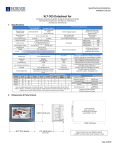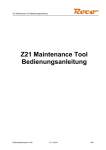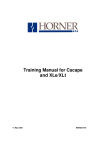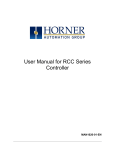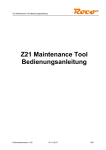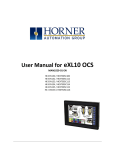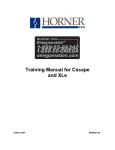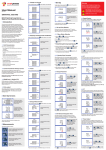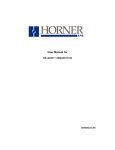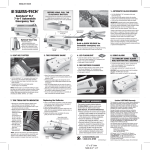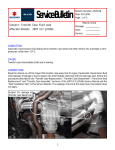Download XL7 OCS Datasheet for - Platforma Internetowa ASTOR.
Transcript
Specifications/Installation MAN0971-02-EN XL7 OCS Datasheet for HE-XW1E0, HE-XW1E2, HE-XW1E3, HE-XW1E4, HE-XW1E5 HEXT391C100, HEXT391C112, HEXT391C113, HEXT391C114, HEXT391C115 1. Specifications General Specifications Required Power (Steady state) Required Power (Inrush) 170mA @ 24VDC 7A for <1 ms @ 24 VDC DC Switched Primary Power Range 10–30VDC Relative Humidity 5 to 95% Non-condensing +/- 20 ppm maximum at 25° C (+/- 1 Minutes per Month) -10°C to +60°C -30°C to +70°C 2lb. (without I/O) Clock Accuracy Surrounding Air Temp Storage Temp Weight US Certifications Europe Certifications UL / CE Control & Logic Specifications Advanced Ladder Logic Control Language Support Full IEC 1131-3 Languages 1MB, maximum Logic Program Size 0.013mS/K & Logic Scan Rate Online Supported in Advanced Ladder Programming Changes Digital Inputs 2048 Digital Outputs 2048 I/O Support Analog Inputs 512 Analog Outputs 512 General Purpose Registers Display Specifications Display Type 7” TFT Transmissive Color Serial Ports Resolution Color Screen Memory 800x480 16-bit (65,535) 27 MB USB mini-B USB A CAN User-Programmable Screens 1023 Ethernet Backlight LED – 50,000 hour life Remote I/O User Configurable within the scan time. Screen Update Rate Removable Memory (perceived as instantaneous in many cases) Input / Output Specifications mA/V mA/V Model DC In DC Out Relays HS In HS Out mA/V In RTD/Tc Out Model 2 12 6 4 4 Model 3 12 12 4 2 2 Model 4 24 16 4 2 2 Model 5 12 12 4 2 2 2 There are 4 high-speed inputs of the total DC Inputs. There are 2 high-speed outputs of the total DC outputs. Model 2, 3 & 4 feature 12-bit Analog I/O. Model 5 features 14/16-bit Analog I/O. High-speed Outputs can be used for PWM and Pulse Train Outputs, currently limited to <65kHz. 50,000 (words) Retentive 16,384 (bits) Retentive 16,384 (bits) Non-retentive Connectivity 1 RS-232 & 1 RS-485 on first Modular Jack (MJ1/2) 1 RS-232 or 1 RS-485 on second Modular Jack (MJ3) USB 2.0 (480MHz) Programming & Data Access USB 2.0 (480MHz) for USB FLASH Drives (2TB) Remote I/O, Peer-to-Peer Comms, Cscape 10/100 Mb (Auto-MDX), Modbus TCP C/S, HTTP, FTP, SMTP, Cscape, Ethernet IP SmartRail, SmartStix, SmartBlock, SmartMod MicroSD, support for 32GB max. Application Updates, Datalogging, more High-Speed Counters Number of Counters 2 Maximum Frequency 500 kHz each Accumulator Size 32-bits each Modes Supported Totalizer Quadrature Pulse Measurement Frequency Measurement 2 Position Controlled Outputs 1 ON/OFF Setpoint per Output 2. Dimensions & Panel Cutout Cutout tolerance to meet NEMA standards is ±0.005” (0.1mm). Max. Panel Thickness is 5mm. Page 1 of 7 Specifications/Installation MAN0971-02-EN 3. Installation Procedures 1. Carefully locate an appropriate place to mount the XL7. Be sure to leave enough room at the top of the unit for insertion and removal of the microSD card. Also leave enough room at the bottom for the insertion and removal of USB FLASH drives 2. Carefully cut the host panel per the diagram on Page 1, creating a 189.7mm x 131.2mm ±0.1mm opening into which the XL7 may be installed. If the opening is too large, water may leak into the enclosure, potentially damaging the XL7. If the opening is too small, the OCS may not fit through the hole without damage. 3. Remove all Removable Terminals from the XL7. Insert the XL7 through the panel cutout (from the front). The gasket needs to be between the host panel and the XL7. 4. Install and tighten the four mounting clips (provided in the box) until the gasket forms a tight seal (max torque 7-10 lb-in. [0.8 – 1.13 Nm]) 5. Reinstall the XL7 I/O Removable Terminal Blocks. Connect communications cables to the serial port, USB ports, Ethernet port, and CAN port as required. 4. Ports & Connectors Page 2 of 7 Specifications/Installation MAN0971-02-EN Page 3 of 7 Specifications/Installation MAN0971-02-EN 5. Safety WARNING: Only qualified electrical personnel familiar with the construction and operation of this equipment and the hazards involved should install, adjust, operate, or service this equipment. Read and understand this manual and other applicable manuals in their entirety before proceeding. Failure to observe this precaution could result in severe bodily injury or loss of life. WARNING: To avoid the risk of electric shock or burns, always connect the earth ground before making any other connections. WARNING: To reduce the risk of fire, electrical shock, or physical injury it is strongly recommended to fuse all Power Sources connected to the OCS. Be sure to locate fuses as close to the source as possible. WARNING: Replace fuse with the same type and rating to provide protection against risk of fire and shock hazards. WARNING: In the event of repeated failure, do not replace the fuse again as a repeated failure indicates a defective condition that will not clear by replacing the fuse. WARNING: Battery may explode if mistreated. Do not recharge, disassemble or dispose of in fire. WARNING: EXPLOSION HAZARD – BATTERIES MUST ONLY BE CHANGED IN AN AREA KNOWN TO BE NON-HAZARDOUS Power input and output (I/O) wiring must be in accordance with Class I, Division 2 wiring methods of the National Electric Code, NFPA 70 for installations in the U.S., or as specified in Section 18-1J2 of the Canadian Electrical Code for installations within Canada and in accordance with the authority having jurisdiction. This equipment is suitable for use in Class I, Division 2, Groups A, B, C, and D or Non-hazardous locations only. WARNING: EXPLOSION HAZARD – Do not disconnect equipment unless power has been switched off or the area is known to be nonhazardous. WARNING: EXPLOSION HAZARD – Substitution of components may impair suitability for Class 1, Division 2. Digital outputs shall be supplied from the same source as the Operator Control Station. Jumpers on connector JP1 and others shall not be removed or replaced while the circuit is live unless the area is known to be free of ignitable concentrations of flammable gasses or vapors. 6. Common Cause of Analog Input Tranzorb Failure A common cause of Analog Input Tranzorb Failure on Analog Inputs Model 2, 3, 4 & 5: If a 4-20mA circuit is initially wired with loop power, but without a load, the Analog input could see 24Vdc. This is higher than the rating of the tranzorb. This can be solved by NOT connecting loop power prior to load connection, or by installing a lowcost PTC in series between the load and Analog input. See SUP0977-01 for additional details. NOTE†: Refers to Model 2 – orange (pg.5,) Models 3 & 4 – J1 (pg.6) and Model 5 – 20mA Analog In (pg.7.) 7. Technical Support For assistance and manual updates, contact Technical Support at the following locations: North America (317) 916-4274 Toll Free: 877-665-5666 http://www.heapg.com e-mail: [email protected] Europe (+) 353-21-4321-266 http://www.horner-apg.com e-mail: [email protected] Page 4 of 7 Specifications/Installation MAN0971-02-EN 8. Built-in I/O (Model 2, 3, 4 & 5) All XL7 models (except the HE-XW1E0) feature built-in I/O. The I/O is mapped into OCS Register space, in three separate areas – Digital/Analog I/O, High-Speed Counter I/O, and High-speed Output I/O. Digital/Analog I/O location is fixed starting at 1, but the Highspeed Counter and High-speed Output references may be mapped to any open register location. For more details on using the HighSpeed Counter and High-Speed Outputs, see the XL7 OCS User’s Manual (MAN0974-01). Model 2 – I/O The XL7 model 2 (HE-XW1E2) features 12 DC Inputs, 6 Relay outputs, and 4 Analog Inputs. The DC Inputs are 12/24Vdc compatible, and can be jumpered for Positive Logic (sinking), or Negative Logic (sourcing). Two of the inputs (H1-H2) can be used for high-speed functions up to 500kHz. The 12-bit Analog Inputs can be jumpered for voltage (0-10V) or current (4-20mA) on a channel by channel basis. The Relay outputs are isolated, supporting AC and DC voltages, with output currents of up to 3A/relay, 5A total. Page 5 of 7 Specifications/Installation MAN0971-02-EN Model 3 & 4 – I/O The XL7 model 3 (HE-XW1E3) features 12 DC Inputs, 12 DC outputs, and 2 Analog Inputs. The XL7 model 4 (HE-XW1E4) increases the I/O count up to 24 DC Inputs, and 16 DC Outputs and 2 Analog Inputs. The DC Inputs are 12/24Vdc compatible, and can be jumpered for Positive Logic (sinking), or Negative Logic (sourcing). Two of the inputs (H1-H2) can be used for high-speed functions up to 500kHz. The 12-bit Analog Inputs can be jumpered for voltage (0-10V) or current (4-20mA) on a channel by channel basis. The 12/24VDC Outputs feature Electronic Short Circuit protection, and support currents up to 0.5A per point, and 4A total. Two of the DC Outputs can be used for high speed functions (PWM or PTO). The output frequency is limited by the switching capability of the output drivers (about 10kHz), although an optional accessory (HE-XHSQ) can be added to provide parallel output drivers supporting frequencies up to 200kHz. Page 6 of 7 Specifications/Installation MAN0971-02-EN Model 5 – I/O The XL7 model 5 (HE-XW1E5) features 12 DC Inputs, 12 DC outputs, with high performance, highly configurable Analog Inputs (2) and Analog Outputs (2). , The DC Inputs are 12/24Vdc compatible, and can be jumpered for Positive Logic (sinking), or Negative Logic (sourcing). Two of the inputs (H1-H2) can be used for high-speed functions up to 500kHz. The 12/24VDC Outputs feature Electronic Short Circuit protection, and support currents up to 0.5A per point, and 4A total. Two of the DC Outputs can be used for high speed functions (PWM or PTO). The output frequency is limited by the switching capability of the output drivers (about 10kHz), although an optional accessory (HE-XHSQ) can be added to provide parallel output drivers supporting frequencies up to 200kHz. The two high resolution Analog Inputs can be configured for 4-20mA, 0-10V, or 0-100mV at 14-bit resolution. They also can be configured for 16-bit temperature measurement – supporting Thermocouples or RTDs with 0.05°C resolution. The Analog Outputs are sourcing, and can be configured for 4-20mA or 0-10V at 14-bit resolution. Each Analog Input or Output channel can be configured independently for maximum flexibility. Page 7 of 7








